Related Research Articles
The Book of Exodus is the second book of the Bible. It is a narrative of the Exodus, the origin myth of the Israelites leaving slavery in Biblical Egypt through the strength of their deity named Yahweh, who according to the story chose them as his people. The Israelites then journey with the legendary prophet Moses to Mount Sinai, where Yahweh gives the 10 commandments and they enter into a covenant with Yahweh, who promises to make them a "holy nation, and a kingdom of priests" on condition of their faithfulness. He gives them their laws and instructions to build the Tabernacle, the means by which he will come from heaven and dwell with them and lead them in a holy war to conquer Canaan, which has earlier, according to the myth of Genesis, been promised to the "seed" of Abraham, the legendary patriarch of the Israelites.
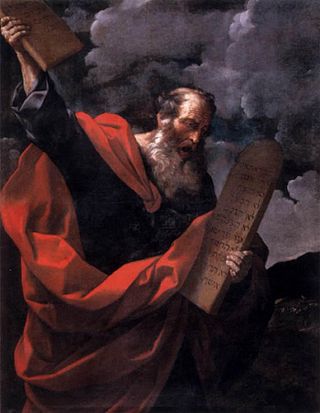
Moses was a Hebrew teacher and leader considered the most important prophet in Judaism and one of the most important prophets in Christianity, Islam, the Druze Faith, the Baháʼí Faith, Samaritanism, and Rastafari. According to both the Bible and the Quran, Moses was the leader of the Israelites and lawgiver to whom the prophetic authorship of the Torah is attributed.

The Crossing of the Red Sea or Parting of the Red Sea is an episode in the origin myth of The Exodus in the Hebrew Bible.

In Jewish and Christian traditions, Jannes and Jambres are the names given to magicians mentioned in the Book of Exodus. This naming tradition is well-attested in ancient and medieval literature. In Latin manuscripts of the New Testament, and in Latin writing traditions, their names are known as Jamnes and Mambres.
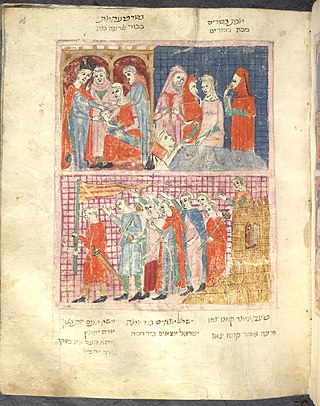
The Plagues of Egypt, in the account of the Book of Exodus, are ten disasters inflicted on biblical Egypt by the God of Israel (Yahweh) in order to convince the Pharaoh to emancipate the enslaved Israelites, each of them confronting Pharaoh and one of his Egyptian gods; they serve as "signs and marvels" given by God to answer Pharaoh's taunt that he does not know Yahweh: "The Egyptians shall know that I am the LORD". The Ten Plagues are recited during the Passover Seder.
The Testament of Solomon is a pseudepigraphical composite text ascribed to King Solomon but not regarded as canonical scripture by Jews or Christian groups. It was written in the Greek language, based on precedents dating back to the early 1st millennium CE, but was likely not completed in any meaningful textual sense until sometime in the Middle Ages. In its most noteworthy recensions, the text describes how Solomon was enabled to build his temple by commanding demons by means of a magical ring that was entrusted to him by the archangel Michael.

The Exodus is the founding myth of the Israelites whose narrative is spread over four of the five books of the Pentateuch.

Zipporah at the Inn is the name given to an episode alluded to in three verses in the 4th chapter of the Book of Exodus. The much-debated passage is one of the more perplexing conundrums of the Torah due to ambiguous references through pronouns and phrases with unclear designations. Various translations of the Bible have sought to make the section clearer through a restructuring of the sentences with a more indirect, yet more straightforward, interpretation.
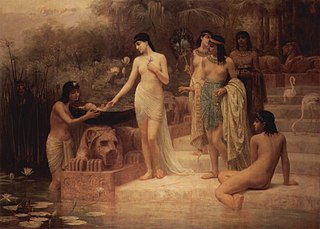
Shemot, Shemoth, or Shemos is the thirteenth weekly Torah portion in the annual Jewish cycle of Torah reading and the first in the Book of Exodus. It constitutes Exodus 1:1–6:1. The parashah tells of the Israelites' affliction in Egypt, the hiding and rescuing of the infant Moses, Moses in Midian, the calling of Moses, circumcision on the way, meeting the elders, and Moses before Pharaoh.
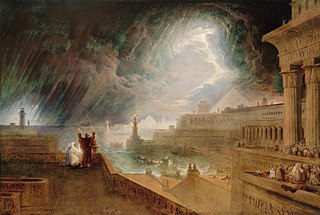
Va'eira, Va'era, or Vaera is the fourteenth weekly Torah portion in the annual Jewish cycle of Torah reading and the second in the Book of Exodus. It constitutes Exodus 6:2–9:35. The parashah tells of the first seven Plagues of Egypt.
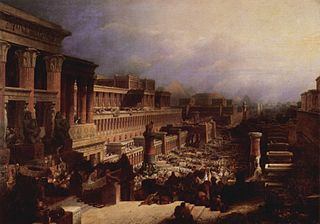
Bo is the fifteenth weekly Torah portion in the annual Jewish cycle of Torah reading and the third in the book of Exodus. The parashah constitutes Exodus 10:1–13:16. The parashah tells of the last three plagues on Egypt and the first Passover.

Beshalach, Beshallach, or Beshalah is the sixteenth weekly Torah portion in the annual Jewish cycle of Torah reading and the fourth in the Book of Exodus. It constitutes Exodus 13:17–17:16. In this parashah, Pharaoh changed his mind and chased after the Israelites, trapping them at the Sea of Reeds. God commanded Moses to split the sea, allowing the Israelites to escape, then closed the sea back upon the Egyptian army. The Israelites also experience the miracles of manna and clean water. And the Amalekites attacked, but the Israelites were victorious.
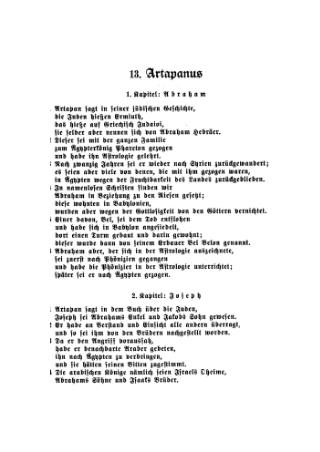
Artapanus of Alexandria was a historian, of Alexandrian Jewish origin, who is believed to have lived in Alexandria, during the later half of the 3rd or 2nd century BCE. Although most scholars assume Artapanus lived in Alexandria, others argue he resided in the countryside. Regardless, Artapanus lived in Egypt.

Ba'al Zabub or Beelzebub, also spelled Beelzebul or Belzebuth, and occasionally known as the Lord of the Flies, is a name derived from a Philistine god, formerly worshipped in Ekron, and later adopted by some Abrahamic religions as a major demon. The name Beelzebub is associated with the Canaanite god Baal.

Exodus is the title given to an Old English alliterative poem in the 10th century Junius manuscript. Exodus is not a paraphrase of the biblical book, but rather a re-telling of the story of the Israelites' flight from Egyptian captivity and the Crossing of the Red Sea in the manner of a "heroic epic", much like Old English poems Andreas, Judith, or even Beowulf. It is one of the densest, most allusive and complex poems in Old English, and is the focus of much critical debate.

The pillar of fire and pillar of cloud are a dual theophany described in various places in the first five books of the Hebrew Bible. The pillars are said to have guided the Israelites through the desert during the Exodus from Egypt. The pillar of cloud provided a visible guide for the Israelites during the day, while the pillar of fire lit their way by night.
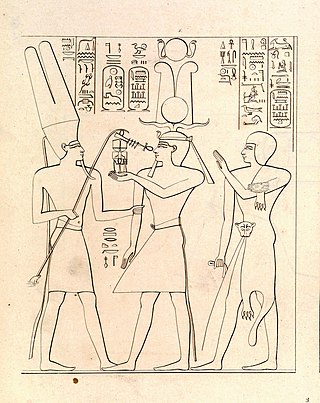
The Bible makes reference to various pharaohs of Egypt. These include unnamed pharaohs in events described in the Torah, as well as several later named pharaohs, some of whom were historical or can be identified with historical pharaohs.

"Finger of God" is a phrase used in the Torah, translated into the Christian Bible. In Exodus 8:16–20 it is used during the plagues of Egypt by Pharaoh's magicians. In Exodus 31:18 and Deuteronomy 9:10 it refers to the method by which the Ten Commandments were written on tablets of stone that were brought down from Mount Sinai by Moses.

Biblical Egypt, or Mizraim, is a theological term used by historians and scholars to differentiate between Ancient Egypt as it is portrayed in Judeo-Christian texts and what is known about the region based on archaeological evidence. Along with Canaan, Egypt is one of the most commonly mentioned locations in the Bible, and its people, the Egyptians, play important roles in the story of the Israelites. Although interaction between Egypt and nearby Semitic-speaking peoples is attested in archaeological sources, they do not otherwise corroborate the biblical account.

The Apocryphon of Jannes and Jambres is a Greek text composed between the 1st and 3rd centuries AD, probably in Roman Egypt. It is a pseudepigraphic account of the legendary ancient Egyptian magicians Jannes and Jambres, purportedly written by one of Pharaoh's officials. Today, it is usually classified as part of the Old Testament apocrypha.